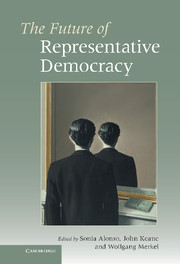Book contents
- Frontmatter
- Contents
- List of figures
- List of tables
- Notes on contributors
- Acknowledgements
- Editors' introduction: Rethinking the future of representative democracy
- 1 Representative democracy and its critics
- 2 Representative democracy and the populist temptation
- 3 The wider canvas: representation and democracy in state and society
- 4 Performance and deficits of present-day representation
- 5 Do parliaments have a future?
- 6 Engendering representative democracy
- 7 Representative democracy and the multinational demos
- 8 Diagnosing and designing democracy in Europe
- 9 Monitory democracy?
- 10 Representing nature
- 11 Democracy and representation beyond the nation state
- General bibliography
- Index
- References
6 - Engendering representative democracy
Published online by Cambridge University Press: 05 June 2012
- Frontmatter
- Contents
- List of figures
- List of tables
- Notes on contributors
- Acknowledgements
- Editors' introduction: Rethinking the future of representative democracy
- 1 Representative democracy and its critics
- 2 Representative democracy and the populist temptation
- 3 The wider canvas: representation and democracy in state and society
- 4 Performance and deficits of present-day representation
- 5 Do parliaments have a future?
- 6 Engendering representative democracy
- 7 Representative democracy and the multinational demos
- 8 Diagnosing and designing democracy in Europe
- 9 Monitory democracy?
- 10 Representing nature
- 11 Democracy and representation beyond the nation state
- General bibliography
- Index
- References
Summary
Introduction
Fifty years ago politics was totally male dominated. In any political institution, a woman was an exception, a stranger. Since then, a process of engendering has taken place in politics, even if women are still vastly under-represented. It has been a slow process with great variations in time and space, and not without backlashes. But in terms of gender composition, the political arena will never look the same as it did in the 1930s and 1950s.
The recent adoption of gender quotas for public elections by countries all over the world represents an attempt to change traditional male dominance in politics and speed up the process of engendering. Although highly controversial, electoral gender quotas have during the last two decades been adopted in constitutions or in legislation in almost fifty countries, while in about fifty additional countries one or more of the political parties represented in parliament have introduced quotas for their own election lists (Dahlerup 2006; www.quotaproject.org).
This trend points to a new understanding of representative democracy – an understanding that is very far from James Mill's argument that a husband can represent the interest of his wife. But also far from the suffragists' demand for formal rights for women to vote and to stand for public election. Today, the global demand is for nothing short of gender balance in representation, or ‘parity democracy’, i.e., 50 per cent women and men in all political decision making.
- Type
- Chapter
- Information
- The Future of Representative Democracy , pp. 144 - 168Publisher: Cambridge University PressPrint publication year: 2011
References
- 6
- Cited by



